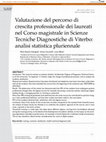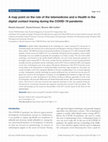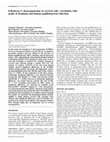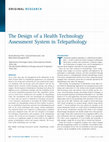Papers by Maria Rosaria Giovagnoli

Introduction. The research intends to evaluate whether the Bachelor Degree of Diagnostic Technica... more Introduction. The research intends to evaluate whether the Bachelor Degree of Diagnostic Technical Sciences of the University "La Sapienza" in Viterbo, helps the change of professional position, and to analyze the students satisfaction. Material and method. Questionnaires have been distributed and telephone interviews have been undertaken with all the students who have attended the course from the beginning of the scholastic year 2007/2008 up 2012/2013. Results. The elaboration of the results has demonstrated that 40% of the students have undergone positive professional changes after the degree course; for example, becoming a university teacher, obtaining a higher leading charge, a managing position or working as researcher. More than 48% among the graduates have declared that the study course has contributed to positive changes in their professional behavior, and that their studies have been useful in the work place. 97% of the students declared their satisfaction with the degree course. Conclusions. Even if the results of the survey have not been compared to the standard level of performance, the analysis of these results has allowed us to underline the students' approval of the course, and in most cases, a growth in the work contest. Vocational training is a wide topic that deals about different objects, starting from the feedback obtained during the training activity, to the details of the development of students' abilities, to the impact on the working organization intended as performance. An example is the Kirchpatrick's traditional model of evaluation. The survey, therefore, allows further considerations for much in-depth analysis.

Italian journal of anatomy and embryology, 2011
The efficiency of cervical cancer screening depends on the proper interpretation of results and o... more The efficiency of cervical cancer screening depends on the proper interpretation of results and on the quality of the sample. For a smear to be considered adequate, cell samples from the endocervix, transformation zone and ectocervix must be present. Our aim was to analyse cervicovaginal smears’ with scanning electron microscopy (SEM), comparing the traditional Ayre’s wooden spatula (Sp) and endocervical cytobrush (Cb) with a new cone-shaped polyurethane (foam) device, the PapCone®(Otto Bock, Duderstadt, Germany). Pap tests were performed with the related informed consent in 22 adult fertile (aged 20-46) women using Sp and/or Cb; sampling with the PapCone® followed 3 months after. The apical extremity of each device was fractured and fixed in toto in 2.5% glutaraldehyde containing vials. Samples were stored at 4°C, postfixed in 1% osmium tetroxide, dehydrated, critical-point dried, mounted on aluminum stubs, coated with platinum, and observed with a Hitachi S-4000 FE-SEM. Statistical analysis was performed evaluating ecto-/endocervical cells, erythrocytes, and/or mucus contained in ten 250x-microscopic fields. There were no significant differences in the number of ectocervical cells and in the quantity of mucus sampled when comparing the 3 devices. The PapCone® sampled significantly more endocervical cells with respect to Sp and Cb, and more erythrocytes with respect to the Sp. These latter data may be due to the characteristic porous and trabecular surface of the PapCone®, which samples a larger volume of material that tends to be also present in less overlapping layers. In conclusion, PapCone® is a better device with respect to Sp and Cb for sampling endocervical cells. Improved cervical sampling will certainly lead to better quality smears and hopefully decrease both false negative and inadequate smear rates.
Healthcare, Jul 7, 2021
This article is an open access article distributed under the terms and conditions of the Creative... more This article is an open access article distributed under the terms and conditions of the Creative Commons Attribution (CC BY
DOAJ (DOAJ: Directory of Open Access Journals), 2010
European Journal of Gynaecological Oncology, 2002

Questo articolo si occupa di un importante problema epidemiologico, la diffusione del carcinoma d... more Questo articolo si occupa di un importante problema epidemiologico, la diffusione del carcinoma della mammella nel mondo occidentale, e del valore della diagnosi precoce nella riduzione della relativa mortalit\ue0. La validit\ue0 degli strumenti diagnostici di uso comune e di quelli pi\uf9 innovativi viene discussa e messa in relazione al costante aumento della difficolt\ue0 diagnostica dei tumori mammari. Si tratta di una rassegna di argomenti noti nella letteratura medica e in gran parte reperibili nei siti internet dedicati a questo tema: in particolare molte delle notizie sull'efficacia dello screening mammografico sono tratte dalle Linee Guida del Piano Sanitario Nazionale. A noi interessa in particolare attirare l\u2019attenzione sui metodi statistici utilizzati per la valutazione dello screening e sulla controversia relativa alla sua efficacia che un paio di anni fa ha coinvolto anche i media. Nelle conclusioni sottolineiamo i vantaggi di un approccio multidisciplinare (uno "sportello unico" anche per le patologie mammarie) con l'auspicio che una maggiore collaborazione tra medici e statistici porti a una razionalizzazione anche economica dei percorsi diagnostici

Journal of public health and emergency, 2021
In public health, independently by the technology use, contact tracing (CT) is the process of ide... more In public health, independently by the technology use, contact tracing (CT) is the process of identifying people who may have met an infected person and subsequent collection of further information on these contacts. The differences between the potential methods of carrying out CT in 2003, during the SARS epidemic, and the current one SARS-CoV-2 are considerable. During the previous pandemic, current mobile technologies were not available (in particular the smartphone as we know it today). The role of the mobile technology-and therefore of the mobile Health (mHealth)-was and is basic during this pandemic for the digital contact tracing (DCT). The review, starting from the introduction of contact tracing performed manually, faced the potentialities and the technologies used for DCT based on dedicated APPs, interrogating on the state of development and on the aspects affecting the effectiveness of the DCT. From this review, various phases of the dissemination of medical knowledge around these Apps emerged. In a first phase, the novelty was high as well as the consequent difficulty on the part of epidemiology to set a concrete approach on them. Subsequently, scientific knowledge has spread, publications have increased and even the great IT giants have moved in the development of solutions. It was highlighted that hundreds of Apps have been/ proposed and/or are under development in the World according to different approaches in terms of the (I) technologies, (II) protocols (Bluetooth and Global Positioning System), (III) centralized governmental choice. The review in a first part extracted some important experiences in this Area captured during the first period; In a second part extracted some important outcomes from research of the next phases. The review ends pointing out the reasons for success/failure of the DCT and the lessons for the future for the epidemiologist.
Journal of Cancer Prevention & Current Research, Oct 30, 2014
European Journal of Cancer and Clinical Oncology, 1991
Gynecologic Oncology, Oct 1, 1999
Objectives. The aim of this study was to detect polycyclic aromatic hydrocarbon–DNA (PAH–DNA) add... more Objectives. The aim of this study was to detect polycyclic aromatic hydrocarbon–DNA (PAH–DNA) adducts in single cervical cells collected during a routine Papanicolaou smear and to relate this carcinogen exposure dose marker to smoking habit.Methods. An immunohistochemical assay, using a polyclonal antiserum raised against benzo[a]pyrene diol epoxide–DNA adducts, was performed to evaluate PAH–DNA adducts in cervical cells collected from 16

European Journal of Cancer, Sep 1, 1999
20%, G3 = 8%, I stage = 54%, II stage = 4%; for volume (>1/2)) G1 = 11%, G2 = 19%, G3 = 27%, I st... more 20%, G3 = 8%, I stage = 54%, II stage = 4%; for volume (>1/2)) G1 = 11%, G2 = 19%, G3 = 27%, I stage = 30%, II stage = 12%. In the (<1/2) group 63% of the patients did not received RT, in the other 32%. Results: In the whole group, relapses were 16.4% (local 8.7%, distant 6.8%, both 0.9%). The incidence of the local relapses (<1/2) vs (>1/2) is 5% vs 11%, distant relapses 3% vs 11%, NED survival after 60 months is 92% vs 73% (p = 0.0001). The most important prognostic factors using multivariate analysis are: for Local relapse Vol. >1/2; for Distant relapse G3, Vol. >1/2, stage II; for Mortality G3, Vol. > 1/2. Radiation therapy decreases significatively the risk for local relapse Discussion: in our series tumoral volume seems to be a very important prognostic factor influencing relapse and mortality rates, as showed in the table. Further studies are required to confirm these data, especially using more precise and rigorous criteria in anatomo-pathological analysis.

Carcinogenesis, Jun 1, 2000
Human subjects in rising the risk of dysplasia was roughly constant through Thirty-six women unde... more Human subjects in rising the risk of dysplasia was roughly constant through Thirty-six women undergoing a routine Papanicolaou smear were enrolled in SIL grades. In conclusion, the immunoperoxidase method, the study. After informed consent was obtained, cervical cells collected by applied to single human cervical cells, provides clear scraping were spread on slides precoated with 0.2% poly-D-lysine. For each patient, two exocervical smears were prepared: the first one was used for evidence that significant differences exist in 8-OHdG con-PAH-DNA adduct immunohistochemical evaluation, and the second smear, tent between normal and dysplastic cells and that oxidative stained by the Papanicolaou method, was utilized for cytological diagnosis. DNA damage might play an important role in cervical Samples were classified in one of three groups [negative, or low-grade or carcinogenesis. high-grade squamous intraepithelial lesion (LGSIL and HGSIL, respectively)] according to the Bethesda System (16). Women with cytological findings consistent with SIL were referred for colposcopy and biopsy. Cytopathological changes indicating human papillomavirus (HPV) infection were quantified on

PubMed, Aug 17, 2005
Background: Microtubules are involved in cell growth and division, motility, signalling and in th... more Background: Microtubules are involved in cell growth and division, motility, signalling and in the development and maintenance of cell shape. Consequently, the non-equilibrium dynamics of these microtubules can be crucial to cellular function, including cancer development. Although the involvement of tubulins in human development has been well investigated, the role of alpha- and beta-tubulins in human tumorigenesis still remains controversial. The aim of this study was to investigate alpha- and beta-tubulin protein expression in rectal cancer development. Patients and methods: By immuno-histochemistry, using alpha- and beta-tubulin monoclonal antibodies, 66 patients were examined, 32 of whom (22 male, 10 female; range 31-60 years, mean age 49.5 years) had preneoplastic lesions discovered during endoscopic surveillance, which were classified as mild, moderate and severe dysplastic polyps of the rectum, and 34 had invasive adenocarcinomas (24 male, 10 female; range 39-60 years, mean 52 years) of the rectum, with no local or distant metastases at the time of surgical resection. Results: In preneoplastic lesions, no statistically significant relationship was found among alpha- and beta-tubulin protein expression, grade of dysplasia, or other clinical data. Statistical association among alpha- and beta-tubulin immunoreactivity and Dukes' stages B and C was found with p = 0.017 and p = 0.009, respectively. No statistical relationship was found between alpha- and beta-tubulin protein expression among different grades of dysplasia. On the contrary, a significant relationship was detected among tubulins in different stages of cancer. Conclusion: In this preliminary study a significant difference of alpha- and beta-tubulin protein expressions was found in polyps and invasive cancer of the rectum, indicating a possible role of tubulins in invasive, but not in preinvasive cancer development. This preliminary data suggest the possibility of performing alpha- and beta-tubulin protein expression in order to identify B stage versus C stage rectal cancer, before surgical treatment.
Healthcare, Oct 11, 2021
This article is an open access article distributed under the terms and conditions of the Creative... more This article is an open access article distributed under the terms and conditions of the Creative Commons Attribution (CC BY

Archives of Environmental Health, Jul 1, 1999
In this study, we evaluated (a) quantitative modifications of dust cells and siderocytes and (b) ... more In this study, we evaluated (a) quantitative modifications of dust cells and siderocytes and (b) qualitative modifications (i.e., cellular changes and inflammatory infiltrate) in sputum of 164 traffic policemen occupationally exposed to environmental pollution in an urban area. Such modifications were correlated with time of exposure and smoking habits. Seventy-three (45%) of the policemen were smokers, and a control group of 119 nonexposed individuals (24% smokers) who resided in a rural district near Perugia, Italy, were examined. The sputa, which was collected for 3 d, were smeared on glass slides stained according to Papanicolaou&amp;amp;#39;s and Perl&amp;amp;#39;s methods. The mean numbers of dust cells in the sputa policemen and the rural population were 103.8 and 12.48, respectively (p &amp;amp;lt; .0001). The numbers of dust cells were highest in policemen who smoked (relative risk = 3.95; p &amp;amp;lt; .006). The mean numbers of siderocytes in policemen and the rural population were 0.99 and 5.31, respectively (not statistically significant, Mann-Whitney test). The difference between the number of subjects with hemosiderin-laden macrophages in traffic policemen and in the control group was small, but it was significant statistically (p &amp;amp;lt; .004). In traffic policemen, it was related to smoking and time of exposure to air pollution, whereas in the control population it was related to heart-pulmonary diseases. In this study, we observed a synergistic effect between smoking and environmental pollution. In addition, less than 5 y of exposure can caused significantly increased (a) numbers of macrophages and (b) inflammatory infiltrate in sputa. The results of the cytological diagnosis revealed a statistically significant difference between policemen and the rural population (p &amp;amp;lt; .001). The cytological exam of sputa and correlations with smoking within each population were not statistically significant. In conclusion, macrophage count in sputum is a sensitive and reproducible method for investigators to verify pulmonary changes that may be observed before they can be measured by functional tests.

Gynecologic Oncology, Dec 1, 1994
Infections with high-risk strains of human papillomaviruses (HPVs) and with herpes simplex virus ... more Infections with high-risk strains of human papillomaviruses (HPVs) and with herpes simplex virus type 2 (HSV 2), as well as inactivation of the p53 tumor suppressor gene, are important cofactors in cervical carcinogenesis. We analyzed 41 paraffin-embedded cervical intraepithelial lesions, including 25 cases of low-grade cervical intraepithelia neoplasia (CIN), and 16 cases of high-grade CIN for the presence of HPV 16/18 and HSV 2 genomic sequences and for the nuclear accumulation of the p53 protein. HPV 16 DNA was detected in 24.% of low-grade CINs and in 43.7% of high-grade CINs. HPV 18 was found only in 8.% of low-grade CINs. None of the cases tested scored positive for HSV 2 DNA. Nuclear accumulation of p53 was found in 4% of low-grade CINs, and in 31.2% of high-grade CINs, including 57.1% of the lesions that were positive for HPV 16. These results indicate that HPV 16 infection was over sixfold more common than HPV 18 infection and that p53 overexpression was significantly associated with high-grade lesions.

Telemedicine Journal and E-health, Aug 1, 2008
Up to a few years ago, the management of the information on the slides (virtual slides) in telepa... more Up to a few years ago, the management of the information on the slides (virtual slides) in telepathology applications was principally based on the design and construction of a few identical and expensive platforms with microscope units and software tools for the display and for electronic control (zooming, moving, and cutting of images). The development of information technology tools allows the diffusion of new visualization strategies and the availability of low cost or free visualization proprietary tools. New competitive systems such as client-server architectures are available in telepathology today. The investigation of the new technologies for telepathology is a basic and core aspect in telemedicine technology assessment. A new interactive environment to investigate the health technology assessment of a telepathology system has been studied. In particular, in consideration of previous experience the methodology focused both on the senior pathologist and younger student pathologist. Two interactive forms were created by a working group: a feedback form and a diagnostic form. The first was designed to investigate the technology characteristics and acceptance of the telepathology systems. The second tool was designed to investigate the diagnostic accuracy on a significant sample of virtual slides by two different groups of pathologists (senior and younger students). The acceptance of the methodology was very high.

Lancet Oncology, Jun 1, 2008
Background In the USA, about 30 200 well-diff erentiated thyroid carcinomas were diagnosed in 200... more Background In the USA, about 30 200 well-diff erentiated thyroid carcinomas were diagnosed in 2007, but the prevalence of thyroid nodules is much higher (about 5% of the adult population). Unfortunately, the preoperative characterisation of follicular thyroid nodules is still a challenge, and many benign lesions, which remain indeterminate after fi ne-needle aspiration (FNA) cytology are referred to surgery. About 85% of these thyroid nodules are classifi ed as benign at fi nal histology. We aimed to assess the diagnostic eff ect of galectin-3 expression analysis in distinguishing preoperatively benign from malignant follicular thyroid nodules when FNA fi ndings were indeterminate. Methods 544 patients were enrolled between June 1, 2003, and Aug 30, 2006. We used a purifi ed monoclonal antibody to galectin-3, a biotin-free immunocytohistochemical assay, and a morphological and phenotypic analysis of FNAderived cell-block preparations. Galectin-3-expression analysis was applied preoperatively on 465 follicular thyroid proliferations that were candidates for surgery, and its diagnostic accuracy was compared with the fi nal histology. Findings 31 patients were excluded because they had small galectin-3-negative thyroid nodules; we did not have data for 47 patients; and one patient with an oncocytic nodule was excluded. 331 (71%) of the assessable 465 preoperative thyroid FNA samples did not express galectin-3. 280 (85%) of these galectin-3-negative lesions were classifi ed as benign at fi nal histology. Galectin-3 expression was detected, instead, in 134 of 465 (29%) thyroid proliferations, 101 (75%) of which were confi rmed as malignant. The overall sensitivity of the galectin-3 test was 78% (95% CI 74-82) and specifi city was 93% (90-95). Estimated positive predictive value was 82% (79-86) and negative predictive value was 91% (88-93). 381 (88%) of 432 patients with follicular thyroid nodules who were referred for thyroidectomy were correctly classifi ed preoperatively by use of the galectin-3 test. However, 29 (22%) of 130 cancers were missed by the galectin-3 method. Interpretation Our fi ndings show that if the option of surgery was based theoretically on galectin-3 expression alone, only 134 thyroid operations would have been done in 465 patients; therefore a large proportion (71%) of unnecessary thyroid surgical procedures could be avoided, although a number of galectin-3-negative cancers could be potentially missed. The galectin-3 test proposed here does not replace conventional FNA cytology, but represents a complementary diagnostic method for those follicular nodules that remain indeterminate.








Uploads
Papers by Maria Rosaria Giovagnoli